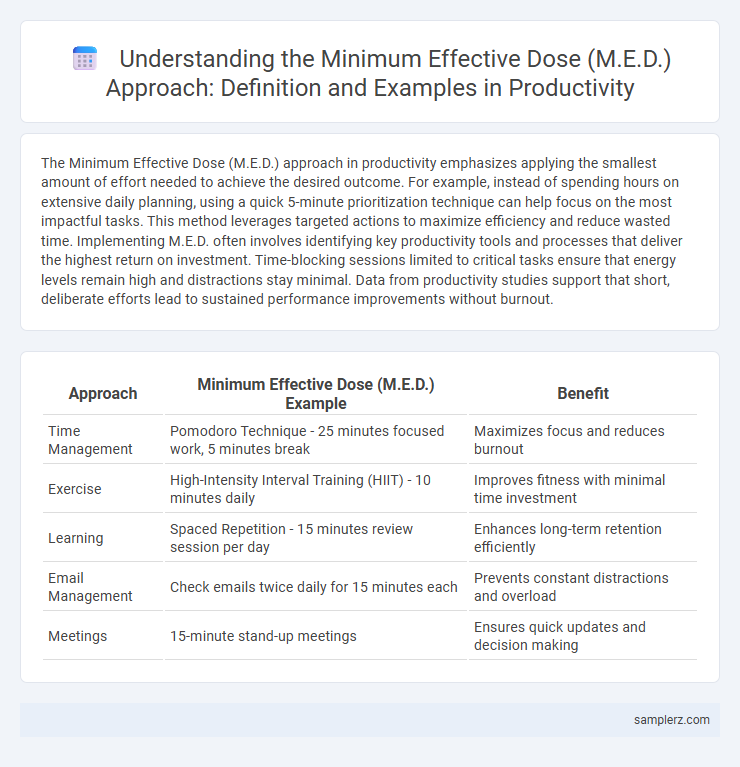The Minimum Effective Dose (M.E.D.) approach in productivity emphasizes applying the smallest amount of effort needed to achieve the desired outcome. For example, instead of spending hours on extensive daily planning, using a quick 5-minute prioritization technique can help focus on the most impactful tasks. This method leverages targeted actions to maximize efficiency and reduce wasted time. Implementing M.E.D. often involves identifying key productivity tools and processes that deliver the highest return on investment. Time-blocking sessions limited to critical tasks ensure that energy levels remain high and distractions stay minimal. Data from productivity studies support that short, deliberate efforts lead to sustained performance improvements without burnout.
Table of Comparison
| Approach | Minimum Effective Dose (M.E.D.) Example | Benefit |
|---|---|---|
| Time Management | Pomodoro Technique - 25 minutes focused work, 5 minutes break | Maximizes focus and reduces burnout |
| Exercise | High-Intensity Interval Training (HIIT) - 10 minutes daily | Improves fitness with minimal time investment |
| Learning | Spaced Repetition - 15 minutes review session per day | Enhances long-term retention efficiently |
| Email Management | Check emails twice daily for 15 minutes each | Prevents constant distractions and overload |
| Meetings | 15-minute stand-up meetings | Ensures quick updates and decision making |
Understanding the Minimum Effective Dose (M.E.D.) Concept
Understanding the Minimum Effective Dose (M.E.D.) concept in productivity highlights the smallest amount of effort needed to achieve the desired result, eliminating wasted time and energy. Applying M.E.D. allows professionals to prioritize high-impact tasks, such as focusing on critical project milestones rather than exhaustive details. This approach streamlines workflows and maximizes output by targeting essential actions that drive measurable progress.
Benefits of Applying M.E.D. to Productivity
Applying the Minimum Effective Dose (M.E.D.) to productivity streamlines workflows by emphasizing only the essential tasks that drive significant results, reducing time wasted on non-critical activities. This approach enhances focus and energy management, leading to sustained productivity gains and minimized burnout risk. Organizations adopting M.E.D. experience improved task prioritization and faster achievement of key performance indicators (KPIs).
M.E.D. in Time Management Techniques
Applying the Minimum Effective Dose (M.E.D.) in time management involves identifying the smallest amount of focused work needed to achieve significant results, such as using the Pomodoro Technique with 25-minute concentrated intervals to maximize productivity. Prioritizing high-impact tasks within these intervals minimizes time wasted on less important activities, ensuring efficient use of available time. Effective M.E.D. application reduces burnout and enhances output by emphasizing quality over quantity in daily work routines.
Streamlining Workflows Using M.E.D.
Streamlining workflows using the Minimum Effective Dose (M.E.D.) approach emphasizes performing only the essential tasks that drive significant progress, reducing wasted effort and increasing productivity. For example, instead of exhaustive project meetings, brief, focused check-ins that address critical issues suffice, saving time and maintaining momentum. Applying M.E.D. results in optimized processes by cutting unnecessary steps, thereby accelerating task completion while preserving quality.
M.E.D. Examples in Email Management
Applying the Minimum Effective Dose (M.E.D.) in email management involves setting specific times to check and respond to emails, such as twice daily at scheduled intervals. Utilizing filters and labels to automatically organize incoming messages reduces decision fatigue and ensures that only essential emails demand immediate attention. This focused approach minimizes time spent in the inbox while maintaining effective communication and responsiveness.
Minimalist Task Lists: M.E.D. in Action
Minimalist task lists exemplify the Minimum Effective Dose (M.E.D.) by concentrating on only the most critical tasks that drive productivity, eliminating unnecessary to-dos that dilute focus. This approach enhances efficiency by ensuring energy is devoted solely to high-impact activities, reducing decision fatigue and maximizing output. Implementing M.E.D. in task management optimizes time usage and fosters consistent progress toward goals.
M.E.D. for Effective Meeting Structures
Implementing the Minimum Effective Dose (M.E.D.) in meeting structures involves setting a strict agenda with only essential topics to maximize productivity and minimize time waste. Limiting meetings to 15-30 minutes ensures focused discussions, encourages concise communication, and accelerates decision-making processes. Utilizing timeboxes for each agenda item prevents over-discussion and maintains momentum throughout the meeting.
Leveraging M.E.D. in Project Planning
Leveraging the Minimum Effective Dose (M.E.D.) in project planning involves identifying the smallest set of tasks or resources that generate the maximum progress toward project goals. This approach minimizes wasted effort by prioritizing high-impact activities such as critical path tasks, essential milestones, and key stakeholder engagements. Applying M.E.D. accelerates decision-making while optimizing resource allocation, ensuring projects advance efficiently without overextension.
M.E.D. Approaches to Learning New Skills
Applying the Minimum Effective Dose (M.E.D.) approach to learning new skills involves identifying the smallest amount of focused practice required to achieve noticeable improvement. Techniques such as deliberate practice sessions limited to 20 minutes daily or emphasizing key fundamentals instead of broad, exhaustive study optimize skill acquisition efficiency. This method reduces burnout and accelerates mastery by concentrating efforts on high-impact activities with measurable outcomes.
Measuring Success: Tracking Your M.E.D. Results
Measuring the Minimum Effective Dose (M.E.D.) for productivity involves setting clear, quantifiable goals such as completing three focused work sprints daily or reducing task completion time by 20%. Effective tracking methods include using digital tools like time-tracking apps and productivity journals to monitor progress and adjust strategies. Regular data analysis helps identify when the M.E.D. is achieved, ensuring optimal effort with maximum output without burnout.

example of M.E.D. (Minimum Effective Dose) in approach Infographic
 samplerz.com
samplerz.com